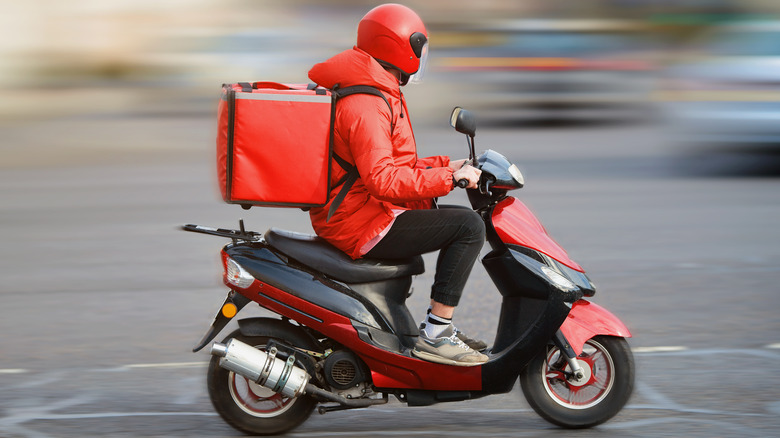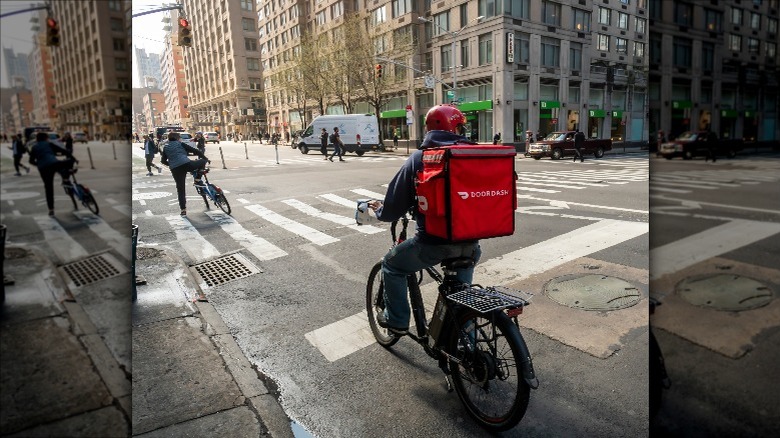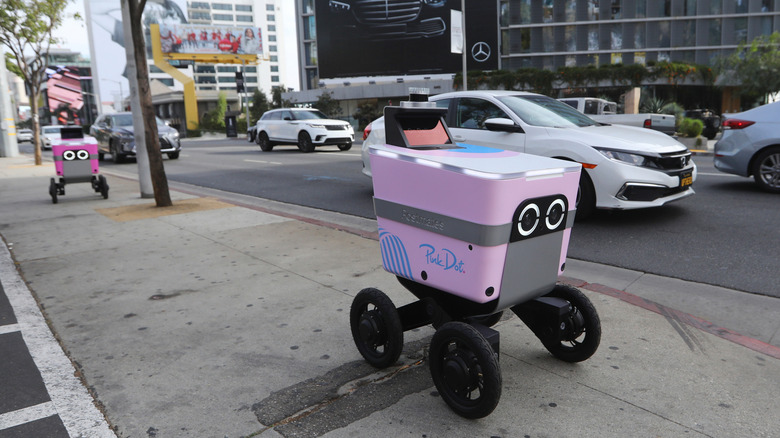How Much Money Do Pizza Delivery Drivers Typically Make?
The COVID-19 pandemic has not so much leveled the landscape for the food industry as it has changed its basic — in favor for some and to the detriment of most others. One of the winners, however, is pizza. The Food Institute reported in December 2021 that major pizza chains saw a six percent increase in sales in 2020. In other words, while other businesses faced an existential crisis, pizza had a field day.
Part of pizza's success can be attributed to it being a brilliant greasy food for the uncertainty of the pandemic. As one person told Fortune in August 2020, "Pizza is the perfect comfort food for me — not too messy, hard to mess up, good whether it's hot or cold, and I don't need silverware."
But, obviously, the main reason for pizza's success is that it is a food that already depended on delivery. The same Fortune piece noted that Pizza Hut saw its best week in eight years during the pandemic. However, Pizza Hut was still losing to Domino's, the sector's king. No matter how you rank Domino's pizzas, one can't deny that it had spent years perfecting its delivery system, so it did not have to turn to Grubhub and DoorDash during the surge in online ordering.
Those sector surveys do not look at the people upon whom such success was built, though. One needs to look elsewhere to see how good their fortune has been.
What do pizza delivery drivers currently make?
Unfortunately, there has not been a governmental or think tank sponsored report into the national state of pizza delivery drivers. However, when looking at the various amounts sites claim a pizza delivery driver typically earns, a reasonably clear picture forms.
Salary.com claims that, as of February 25, the median amount a driver can expect to make per hour is between $10 and $12. Indeed, though, offers the more lucrative view of $16.40 per hour, while Glassdoor estimates the annual salary of a pizza delivery driver to be $52,899. They come to this number by assuming a base salary of $33,161, which works out to about $15 per hour, and an additional pay of $19,738 from tips.
The additional pay is an important factor because it is the unknowable amount that people will tip. While writing about drivers for delivery apps, Glamour suggests a tip of 20%. However, a recent report that the digital payment company Square shared with Nexstar also shows that people have recently begun to tip about 18.6% for a quick service restaurant while they shell out the slightly larger amount of 19.12% for a full service one. Even though delivery drivers would not get tips given to restaurants, it shows that they can expect to make at least slightly more than their hourly rate, depending on the generosity of their customers.
How does being a pizza delivery driver compare to delivery apps?
One major shift in the pizza delivery driver landscape is the pandemic-driven surge in delivery app drivers. While many pizzerias depend on delivery apps to get their orders, it is by no means as ubiquitous as it is for more general restaurants. This, again, is in part because pizzerias have long relied on delivery.
The biggest difference between the two is that one is a hired worker and the other is a contractor. A glance at Indeed postings for pizza delivery drivers shows that the job is consistently part-time and comes with a regular schedule. On the upside, that means guaranteed hours. On the downside, it means you have to show up.
A second difference informed by the first is that the app drivers will have to pay a self-employment tax on the amount they make. The tax, which covers the social security and medicare taxes that come out of a worker's paycheck, is 15.3%.
A third difference brought up in a Reddit conversation about the merits of working for a pizza store versus a delivery app is that those who work for a store do not necessarily have to worry about ratings like their app-based counterparts.
Again, the alternative is more freedom and flexibility. So, how the job is depends on what one wants out of it.
What does the future of pizza delivery look like?
These are all current options. However, the boom of delivery has also meant that finding ways to cut the cost of delivery now has added motivation. After all, if a company can save $30,000 a year, it probably will do so by any means necessary.
So, it should not surprise anyone that Domino's began to experiment with robot delivery units in April 2021. According to CNN, it began testing the fully autonomous devices in Houston. Customers could choose to have their food delivered via robot. If they did so, they would receive a code that would unlock the robot's pizza compartment upon its arrival. In June, the smaller chain Southside Flying Pizza launched a similar program in Austin.
As of now, drivers can take comfort in the fact that we have been promised autonomous vehicles for years. For example, in January, Uber's robotics company, Serve Robotics, has announced that it's reached the point where its units can travel without people in certain areas. And that's not taking into account anti-robotic cities like Philadelphia. So, it seems it will be a while yet before sci-fi visions of mass unemployment hit the delivery industry. Moreover, it will be even longer before smaller businesses find investing in these robots a smarter move than just paying for a pizza delivery driver.



